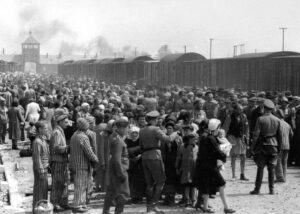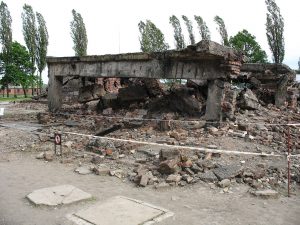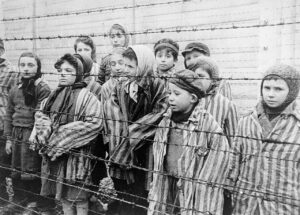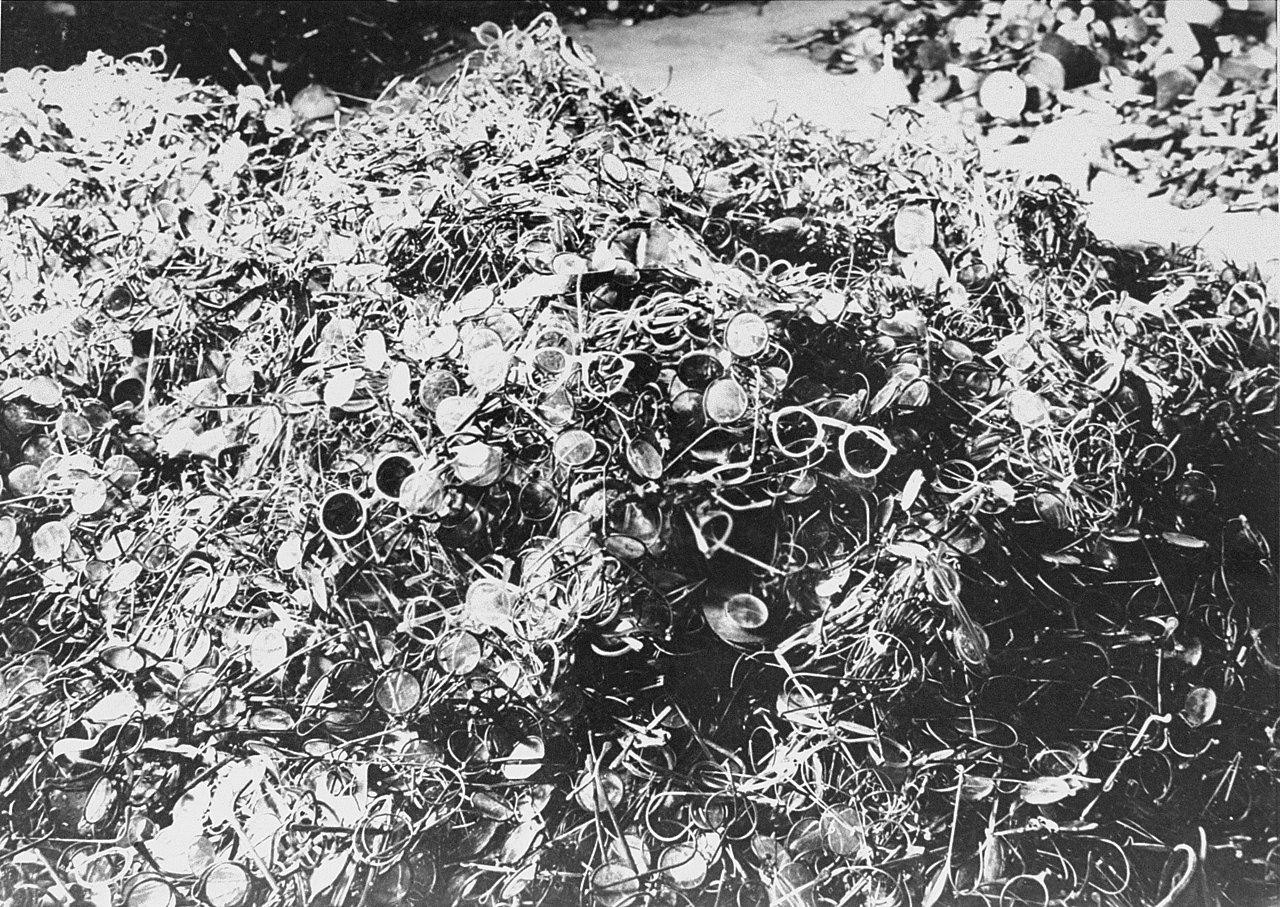The end of Auschwitz came on 27 January 1945. That day, soldiers of the 60th Army of the 1st Ukrainian Front of the Red Army took control of the vast camp area. About seven thousand prisoners, including several hundred children, lived to see liberation in Auschwitz, Birkenau and Monowitz. The majority of the nearly 60,000 prisoners in the entire camp complex had been evacuated earlier in what is called ‘death marches’ to the west. Since 2005, 27 January has been celebrated as International Holocaust Remembrance Day.
by Bogusław Kopka
Although as closing the history of the largest death factory where a million Jews perished it is a symbolic date, it did not mark the end of the Nazi German camps. The concentration camp system, in continuous operation since 1933, collapsed abruptly just as it was reaching its zenith; the ‘peak and collapse occurred simultaneously’. (Nikolaus Wachsmann). On the eve of the evacuation of Auschwitz, i.e. 15 January 1945, the SS reported a record number of 714,211 prisoners in the camps. In the following months, they were transformed into large concentration centres, overflowing with prisoners from other evacuated camps constantly arriving by rail and on foot. Those camps remained in constant motion until the end of the war, despite the impending defeat of the Third Reich. In 1945, the SS and police chief Heinrich Himmler was determined to keep most of the prisoners as hostages – a bargaining chip in his planned talks with the Allies. Above all, however, the prisoners’ slave labour was used. The last concentration camp ceased operating two days after the end of the war in Europe, on 9 May. That was Stutthof, located far from human settlements on the Vistula Spit.

Auschwitz is not just a symbol of the genocide committed against European Jews. Its first inmates were Poles. On 14 June 1940, 728 Polish political prisoners arrived at Auschwitz from the prison in Tarnów; they were given camp numbers from 31 to 758. Ones with numbers from 1 to 30 were German criminals who had arrived from Sachsenhausen and served as prisoner functionaries (kapos). Auschwitz was used to terrorise the population of occupied Poland and to kill a significant part of its elites: political activists, clerks, military officers, scientists, teachers, athletes, scouts, lawyers, physicians and clergymen. After the outbreak of the Warsaw Rising, the Germans deported the civilian population of the capital, including women and children, to the camp. It is estimated that about 150,000 Poles were imprisoned in Auschwitz, while 75,000 died.
With the outbreak of the German-Soviet War in 1941, Soviet prisoners of war (POWs) arrived in the camp. It is estimated that at least 15,000 were sent to Auschwitz. Three thousand were killed soon after being brought to the camp. They were the first group of prisoners in Auschwitz to be tattooed with identification numbers.
The years 1942–1944 saw mass killing of Jews in gas chambers, half of those murdered were from Hungary arriving at Auschwitz-Birkenau in the last year of its operation. It is worth mentioning that most Polish Jews were murdered in the extermination centres of Operation Reinhardt, which, apart from Majdanek, were completely destroyed and razed to the ground before the Red Army came from the east. Two million more Jews were murdered in Belzec, Sobibor and Treblinka in the General Government than in Auschwitz-Birkenau.

Not far from Auschwitz, the large industrial camp Monowitz and its branches were built between 1942 and 1943, where on average prisoners died of exhaustion after three months. Cooperation between the SS and German industry played a key role in the expansion of the camp (the IG Farben company being its main beneficiary).
The occupation of the Auschwitz camp was completed instantaneously. ‘The town of Oświęcim and the camp were occupied, as it were, on the way along which the Soviet offensive rolled in January 1945,’ Professor Tadeusz Panecki aptly observed. When the gates of Auschwitz-Birkenau opened, not just the surviving prisoners were surprised but the Red Army itself. Before that, their commanders and they themselves did not know what they would find taking control of Oświęcim, which had borne the German name Auschwitz since October 1940. For Soviet commander-in-chief Joseph Stalin, the overriding goal was to capture the Upper Silesian Industrial Region as quickly as possible. The commander of the 1st Ukrainian Front Marshal Ivan Konev recalled: ‘Stalin, as I understood it, highlighted that fact when he said, pointing to the map and circling the boundaries of the region: Gold’. No-one from Moscow informed the commanders and soldiers, not even by a special order, that there would be a concentration and extermination camp on the way in their front-line fighting. The fact of the existence of this largest German ‘state concentration camp’ was known to the Allies, both Western and Soviet. In 1944, American military aircraft took detailed photographs of the entire area, clearly showing the gas chambers and crematoria in operation, which were blown up in late 1944 and early January 1945 as part of the cover-up of the crime. Information about what was happening behind the camp’s wires was passed on to the free world by the military conspiracy organised by a Pole, Cavalry Master Witold Pilecki. Pilecki himself was the author of detailed reports from Auschwitz. Soviet partisan intelligence and the NKVD also must have known about this place of extermination. During the war, the leaders of the USA, Great Britain and the Soviet Union were interested in ending military operations on the Old Continent as soon as possible. They did not regard the German concentration camps and extermination centres as military infrastructure to be destroyed first.

Nobody was prepared to help the survivors. Chaos and improvisation reigned. There was, however, no shortage of clothes, which were in ‘Canada’, i.e. a large sector where the property of the murdered Jews was stored (the SS hurriedly set fire to these warehouses but the blaze did not manage to consume all the looted property, which was to be taken to the Reich before evacuation). Before the sanitary columns arrived with medical aid and food, a front cameraman, Capt. Alexander Vorontsov, arrived and filmed what he saw on the spot, interviewing eyewitnesses. The interviews were very short and fragmentary, because the survivors did not have the strength to talk and there was wartime censorship. He was shocked, although he had already seen a lot of the war. The films he recorded with his camera show (available online) how several weeks after the memorable 27 January it was possible to transport exhausted and weakened prisoners from the Birkenau camp in horse-drawn carts to the brick blocks of Auschwitz I (Stammlager), where a hospital was established. The Polish Red Cross Camp Hospital, directed by Dr Józef Bellert, was also established in Oświęcim and succeeded in saving the lives of almost five thousand people. The prisoners suffered from many serious illnesses, such as typhoid fever and tuberculosis, not to mention mental illnesses (depression, neuroses). Among the seriously ill were victims of the pseudo-medical experiments of Dr Josef Mengele, who managed to escape to Latin America, where he died in 1979. One of the former Auschwitz prisoners who worked in the Soviet lazaretto, Eddy de Wind, a Dutch physician of Jewish origin, was the first to recognise the post-concentration camp syndrome (KZ syndrome), which he described in an article published in 1946 titled ‘Confrontatie met de dood’ [Confrontation with death] (his memoirs published for the first time in 1946 were published in Polish in 2020 as Stacja końcowa Auschwitz. Moja historia z obozu [Terminus Auschwitz. My story from the camp]). Dr Antoni Kępiński later conducted research on the KZ syndrome. The work of Kępiński and his colleagues at the Psychiatric Clinic of the Medical Academy in Kraków contributed to the inclusion of KZ syndrome in the international classification of mental illnesses.
The most dangerous, however, were infectious diseases that could pose a serious threat to soldiers and local residents. Hence the decision to isolate former prisoners. They were ‘free people, but not liberated’. Whoever had enough strength tried to escape as quickly as possible from this cursed place, which was not always successful. When they met a Soviet patrol on the road, they were turned back to the camp. An additional danger for women were Red Army men, who committed rapes under the influence of alcohol.

In October 1945, the American journalist Gladwin Hill wrote about the Auschwitz camp in The New York Times: ‘The camp still exists. It is supervised by the Polish authorities and, as before, fenced off from the world with electrically charged barbed wire’. In the spring of 1945, the NKVD established two special transit camps on the site of Auschwitz (a similar pattern of NKVD activity could be observed in the summer-autumn of 1944 at Majdanek and in 1945 in all ‘liberated’ camps in Germany). The first of them was initially located in the western part of the former German camp, and from June it covered the whole area. The other was located in two sectors of the former Birkenau. Over twelve thousand people were held in both. The Auschwitz camp (formerly Auschwitz I) held German POWs, while in Birkenau the Soviet authorities kept civilians from Upper Silesia, the Opole region, and the Bielsko-Biała area. It can be said that Oświęcim and its surroundings became a Soviet ‘prisoner-of-war centre’ in southern Poland. In these camps, the Soviet security authorities carried out selection, looking for people capable of manual labour, who were then sent by rail transport to labour camps deep inside the USSR. Some of the movable property that was considered war trophy was also taken to the Soviet Union, including a significant part of the German camp’s archive. Attempts were even made to remove the wrought-iron gate of Auschwitz with the inscription ARBEIT MACHT FREI, without success.
See more:The voices of the survivors are the most important
Finally, as a result of the intervention of Silesian Governor General Aleksander Zawadzki with Marshal Konstanty Rokossowski, the Soviet camps in Oświęcim were closed in September 1945. Poles selected on the basis of their nationality were allowed to return home, while Germans and POWs were sent to the Soviet Union, and the others to the labour camp in Oświęcim, which was administered by the Bielsko-Biała District Office of Public Security. Some of the equipment from the Oświęcim barracks was taken to the prison at Montelupich Street in Kraków. The 1947 decision by the Sejm to establish the Auschwitz-Birkenau State Museum at this site prevented the complete devastation and dismantling of the buildings of the former German Auschwitz-Birkenau concentration camp. It was established through the efforts of former prisoners to preserve the remains of the former Nazi German concentration and extermination camp ‘for all time’.
Author: Bogusław Kopka
Translation: Alicja Rose & Jessica Sirotin
Bogusław Kopka is a historian and the author of the books: Obozy pracy w Polsce 1944–1950. Przewodnik encyklopedyczny [Labour camps in Poland 1944–1950. An encyclopaedic guidebook] (2002); Konzentrationslager Warschau. Historia i następstwa [History and consequences] (2007); Gułag nad Wisłą. Komunistyczne obozy pracy w Polsce 1944–1956 [The Gulag upon the Vistula. Communist labour camps in Poland 1944–1956] (2019).





